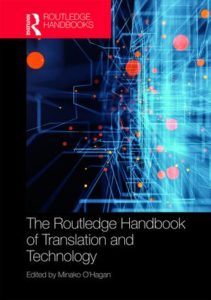 The Routledge Handbook of Translation and Technology Edited by Minako O’Hagan
The Routledge Handbook of Translation and Technology Edited by Minako O’Hagan
The Routledge Handbook of Translation and Technology provides a comprehensive and accessible overview of the dynamically evolving relationship between translation and technology.
Divided into five parts, with an editor’s introduction, this volume presents the perspectives of users of translation technologies, and of researchers concerned with issues arising from the increasing interdependency between translation and technology. The chapters in this Handbook tackle the advent of technologization at both a technical and a philosophical level, based on industry practice and academic research.
Containing over 30 authoritative, cutting-edge chapters, this is an essential reference and resource for those studying and researching translation and technology. The volume will also be valuable for translators, computational linguists and developers of translation tools.
Table of Contents
List of Illustrations
List of Contributors
Acknowledgements
Chapters
Introduction – Translation and technology: disruptive entanglement of human and machine – Minako O’Hagan
Part I: Translation and Technology: Defining Underlying technology – Present and Future
1. Standards for the language, translation, and localization industry – Sue Ellen Wright
2. XML for translation technology – Johann Roturier
3. Terminology extraction and management – Kyo Kageura & Elizabeth Marshman
4. Building and using parallel text for translation – Michel Simard
5. Speech recognition and synthesis technologies in the translation workflow – Drago̧ Ciobanu & Alina Secară
Part II: Translation and Technology: Users’ Perspectives
1. Multinational language service provider as a technology user – Bert Esselink
2. Applications of technology in the Patent Cooperation Treaty (PCT) Translation Division of the World Intellectual Property Organization (WIPO) – Colm Caffrey & Cristina Valentini
3. Small and medium-sized enterprise (SME) translation service provider as a technology user: Translation in New Zealand – Patrick King
4. Freelance Translators’ Perspectives – Jost Zetzche
5. Language learners and non-professional translators as users – Masaru Yamada
Part III: Translation and Technology: Application in a Specific Context – Shaping Practice
1. Technology, technical translation and localization – Debbie Folaron
2. Technology and game localization: translation behind the screens – Nathan Altice
3. Technology and non-professional translation – Miguel A. Jiménez-Crespo
4. Technological advances in audiovisual translation – Jorge Díaz Cintas & Serenella Massidda
5. Technology and interpreting – Sabine Braun
6. Technology and sign language – Peter Llewellyn-Jones
7. Translation technology and disaster management – Sharon O’Brien
8. Post-editing of Machine Translation – Lucas Nunes Vieira
Part IV: Translation and Technology: Research Foci and Methodologies
1. Translation technology evaluation research – Stephen Doherty
2. Translation workplace-based research – Maureen Ehrensberger-Dow & Gary Murphy
3. Translation technology research and human-computer interaction – Samuel Läubli & Spence Green
4. Sociological approaches to technology – Maeve Olohan
5. Translation technology research with eye tracking – Arnt Jakobsen
Part V: Translation and Technology: Overarching Issues
Future of Machine Translation: musings on Weaver’s memo – Alan Melby
1. Quality – Antony Pym
2. Fit-for-purpose translation – Lynne Bowker
3. Copyright and the reuse of translation as data – Joss Moorkens & David Lewis
4. Media accessibility and accessible design – Aline Remael & Nina Reviers
5. Technology and translator training – Dorothy Kenny
6. Translation, technology and climate change – Michael Cronin
Index
https://www.routledge.com/The-Routledge-Handbook-of-Translation-and-Technology-1st-Edition/OHagan/p/book/9781138232846
 The Routledge Handbook of Translation and Technology Edited by Minako O’Hagan
The Routledge Handbook of Translation and Technology Edited by Minako O’Hagan